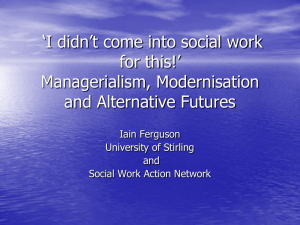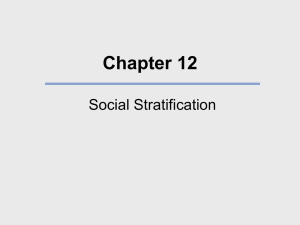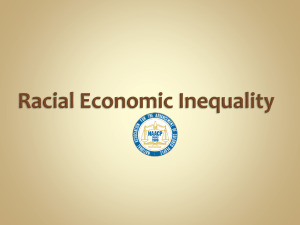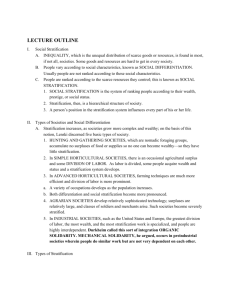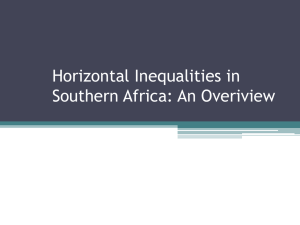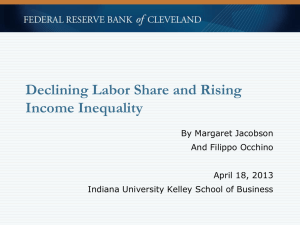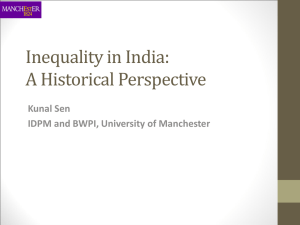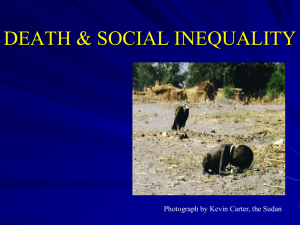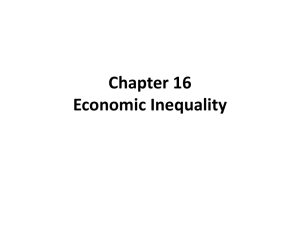Social Stratification
advertisement
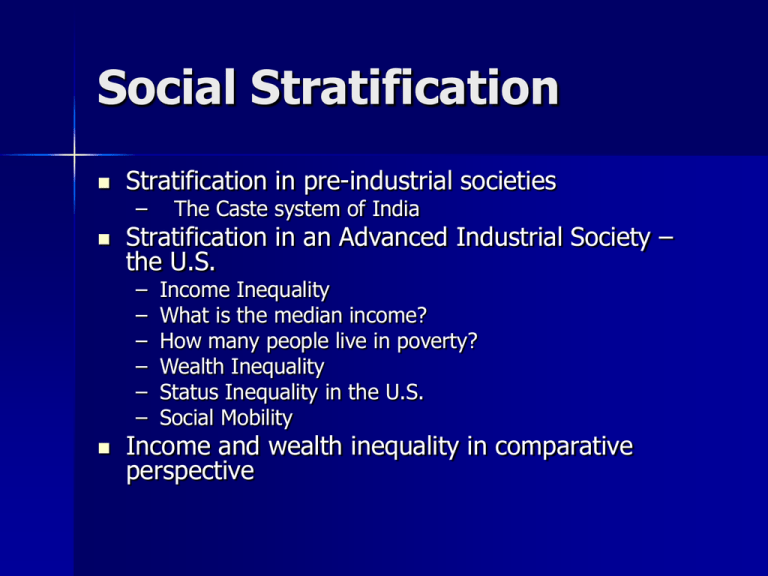
Social Stratification Stratification in pre-industrial societies – Stratification in an Advanced Industrial Society – the U.S. – – – – – – The Caste system of India Income Inequality What is the median income? How many people live in poverty? Wealth Inequality Status Inequality in the U.S. Social Mobility Income and wealth inequality in comparative perspective Stratification in preindustrial societies Very little stratification in hunting and gathering societies Nobody owns much, so there is no basis for inequality. Primary differences are differences in prestige or social honor (status) Good hunters, weavers, older people etc. are given prestige In horticultural societies people are more settled in one place and own more, so there is more stratification If a horticultural society is a tribe, there may be no leaders or someone referred to as a “big man.” Men compete for status by holding feasts and giving away food and goods. The man who holds the biggest feast and gives away the most becomes the big man of the tribe. Big men are not permanent leaders and cannot bequeath their position Sometimes horticultural societies have chiefs, or permanent leaders who can bequeath their position to their children. Now we see status group differences between the chief, his family and his retainers (who become the aristocracy) and the common people Most of these differences concern rules of behavior and dress Dress codes can be so elaborate for aristocrats that they are a physical handicap. Zulu warrior Material differences between aristocrats and commoners are not great. Inequality reaches its maximum in agrarian societies. At the top is a monarch who is hugely wealthy. There is also a large aristocracy – the ruling class Below the aristocracy is the retainer class of top officials, soldiers and servants. Most people are part of the peasantry, the vast majority of people who work the land. Below the peasantry are groups of slaves, craftsmen, and degraded classes who work as tanners or garbage collectors. Below them are groups of beggars and the destitute. There are vast differences between the lifestyle of the monarch and the aristocracy and the peasants and lower classes. The caste system of India This system of ranked groups of people in agrarian societies reaches its most rigid form in the Indian caste system. Each caste is an endogamous, hereditary group. Brahmins- priestly class Kshatria - rulers and aristocrats Vaisia - landlords and business men, or. Sudra, the peasantry and those who work in non-polluting jobs. Untouchables- those who work in unclean jobs such as garbage collection, etc. The first three castes have social and economic rights which the Sudra and the untouchables do not have. Interaction between the castes is strictly regulated, and there are penalties for people who do not follow the rules. Stratification in the U.S. Inequality can be by money (class) or status Class inequality can be inequality by income or inequality by wealth (property, stocks and bonds, savings) Income Inequality In 2007, the top fifth of households in the U.S. earned nearly half of all income. Equivalence income takes into account the number of people living in the household Which states have the most income inequality? Has income inequality been getting better or worse? Percent change in Gini coefficient, U.S. Higher coefficients mean more inequality. In which states do people earn the most? Income is usually referred to as median income That is the income of someone who is the very middle of the income scale. Median income is highest on the east and west coasts Has median income been rising or falling? Is that because women are working? How about poverty? Is that getting better or worse? Mostly it seems to be getting better Fewer people are living in poverty Wealth Inequality Net worth refers to equity in home, stocks, bonds, IRAs, 401k accounts, savings, equity in vehicles, etc. It is a measure of wealth Figures shows median net worth by income In 2002, households in the highest fifth of income earners had substantially higher net worth than anyone else. How has net worth changed over time? Status Inequality in the U.S. There are status groups in American society that may be defined by their style of life. The ranking of a status group often corresponds to its income and wealth ranking, but not always. Status groups in the U.S. The top out of sight group- This group lives entirely on inherited capital. This is most prestigious if it is at least 3 to 4 generations old (e.g. Rockefellers). The upper- This group inherits a lot of their money but earns a lot too, “usually from some attractive, if slight work, without which they would feel bored or even ashamed.” This work might be controlling banks or older corporations, think tanks, or foundations. Upper middle -This group may have as much money as the upper group, but they earned it from law, medicine, finance, oil, shipping, real estate or the more honorific kinds of trade such as art. Middle -The middle is the most earnest and insecure group. Middle class people are very concerned about what people think of them and often obsessed with doing everything right. Middle class people have jobs in the middle ranks of companies. High Proletarian -This group is made up mostly of blue collar workers, people who skilled workers and craftspeople. People in this group are proud of their work and are tempted to call what they do a profession. Mid proletarian-This group is made of operators like bus drivers, truck drivers and heavy equipment operators. They tend to have more supervision in their jobs than the high proletarians. Low proletarian-These people have uncertain employment such as seasonal jobs. They are highly supervised on the job and often prefer social isolation outside of work. Destitute-These people never have even seasonal work but live wholly on welfare. Bottom out of sight-The homeless, and those in charitable or correctional institutions. Social Mobility How easy is it to move up (or down) the class structure in the U.S.? Research shows that in most industrial societies there has been considerable upward mobility over the course of the 20th century. Much of that mobility, however, is due to changes in the available jobs, and the proliferation of white collar jobs (that are generally higher prestige) and the disappearance of blue collar jobs (that are generally lower prestige) When changes in the nature of available jobs is factored in, the amount of mobility has not change that much in over a century. How does the U.S. compare to other industrial societies? The United States is by far the richest nation. Why? Americans work harder – longer hours every day and more weeks per year. Unemployment tends to be low in U.S. More U.S. couples are dual earner couples. At the same time, the U.S. has the highest level of income inequality. The U.S. also has a larger percentage of people in poverty.

